
You’re a conscious traveler.
When you visit a new country, it’s not just about adding a new stamp in your passport. It’s about making the most of your time abroad and leaving a positive impact. Read our guide below to learn about the best ways to travel responsibly and sustainably in Peru.
Responsible travel is an entire movement that encompasses a wide range of sustainable, environmental, and culturally sensitive ways to practice tourism. Collectively, these efforts—both big and small—are making PLANET EARTH a better place.
“Responsible travel to natural areas that conserves the environment, sustains the well-being of the local people, and involves interpretation and education.” (TIES, 2015)
We live in a time when air travel shrinks distances to provide unprecedented access to almost any place we want to visit. With sufficient time, effort and money, we can reach the most remote corners of the earth. But what are the impacts of quick access to areas that were previously difficult to visit? In South America specifically, what happens when year after year thousands of people hike to historic sites like Machu Picchu or when we venture to the deepest Amazon or when we visit a traditional community in search of authentic culture?
Responsible travel is an umbrella term that encompasses a wide range of sustainable, environmental, and culturally sensitive ways to practice tourism. The idea is that, rather than being a source of harm, tourism can be a tool for conservation and sustainable community development.
At Peru for Less we love to help fellow travelers plan their dream vacation to Peru and we find it only right to give back to the people and places that make this country so special. We feel that it is important to bring attention to and support the hard work of nonprofit organizations and eco-friendly businesses in Peru and to share some helpful tips for visiting Peru. By doing so, we hope to enable connections between conscious travelers and exciting sustainable efforts in Peru and to inspire everyone to travel responsibly.

A woman drinks from a reusable water bottle.
Responsible travel can take many forms, ranging from huge government initiatives to small personal decisions. At the level of the individual, traveling responsibly means being aware of the impacts of tourism and acting to make those impacts positive when possible. It’s about choosing where to travel (or not travel); what mode of transport to take; what to pack; where to buy, sleep, and eat. These are choices over which we have control. When we book with a travel agency or tour operator, it’s about ensuring that their policy is to educate travelers about the local culture and the environment, to give back to the communities they work in, to fulfill and exceed minimum workplace standards in their countries, and to support sustainability projects that intend to preserve the planet’s wonders for future generations.
From booking an outdoor excursion to enjoying 5-star luxury comforts, the decisions you make about what to do and where to stay on your vacation can help leave a positive impact on the places you visit. Here are 10 easy ways to be a responsible traveler.
Unplug those energy-sucking appliances, including plasma televisions, video games, laptops, DVD players and cell phone chargers before leaving on your trip. Each year about 10 percent of all energy is wasted in the United States because appliances are left plugged-in when they’re not in use. It’s not only the environmentally friendly thing to do, but you’ll also see the savings on your next energy bill.
Cut your emissions and plan a travel itinerary with environment-friendly transportation: bike, walk and take public transit. These earth-friendly alternatives are often cheaper than paying for a cab or renting a car and offer a unique way to observe and interact with locals.
Carry your travel purchases and souvenirs in reusable bags to cut out waste so that less plastic packaging finds its way to the trash and landfills. Additionally, instead of printing out all your travel information on numerous pieces of paper, download maps and travel guides to your smartphone or tablet to reference throughout your trip. Most hotels, restaurants and cafes throughout Peru offer free wireless Internet, which means that your travel information will be at your fingertips whenever you need it.
Think twice before throwing your recyclables into the trash even when you don’t see a recycling bin. Each city in Peru has different recycling resources so ask your hotel where you can deposit your recyclables.
Stay hydrated during your trip by carrying a reusable water bottle that you can refill from a larger gallon source; smaller plastic water bottles create a lot of waste. Pack reusable containers to carry food and snacks to further reduce packaging.
There are a huge number of nonprofit organizations in Peru that could benefit from your support. Before buying gifts to share, be sure to ask your travel agency or guide what items will be the most useful.
Environmental problems don’t go on vacation when you take a trip. In Peru, stay on marked trails while trekking in the Andes and stay with your guide on a visit to the jungle. Avoid disturbing the natural environment or interfering with natural behavior by feeding wild animals.
In the long run, mass tourism is an unsustainable way to travel. Large packaged tours organize huge groups of travelers who move around in big buses, climb on and off to gawk at sights and snap photos, and interact only minimally with the people and culture of the host country. This mode of travel stretches the limits of natural resources, it dilutes authentic local traditions, and it often benefits a few big players at the expense of impacted communities. When booking tours, it’s important to know whether the company employs local guides – people who grew up in the area can lend an insider perspective and a deeper understanding of the local culture and community.
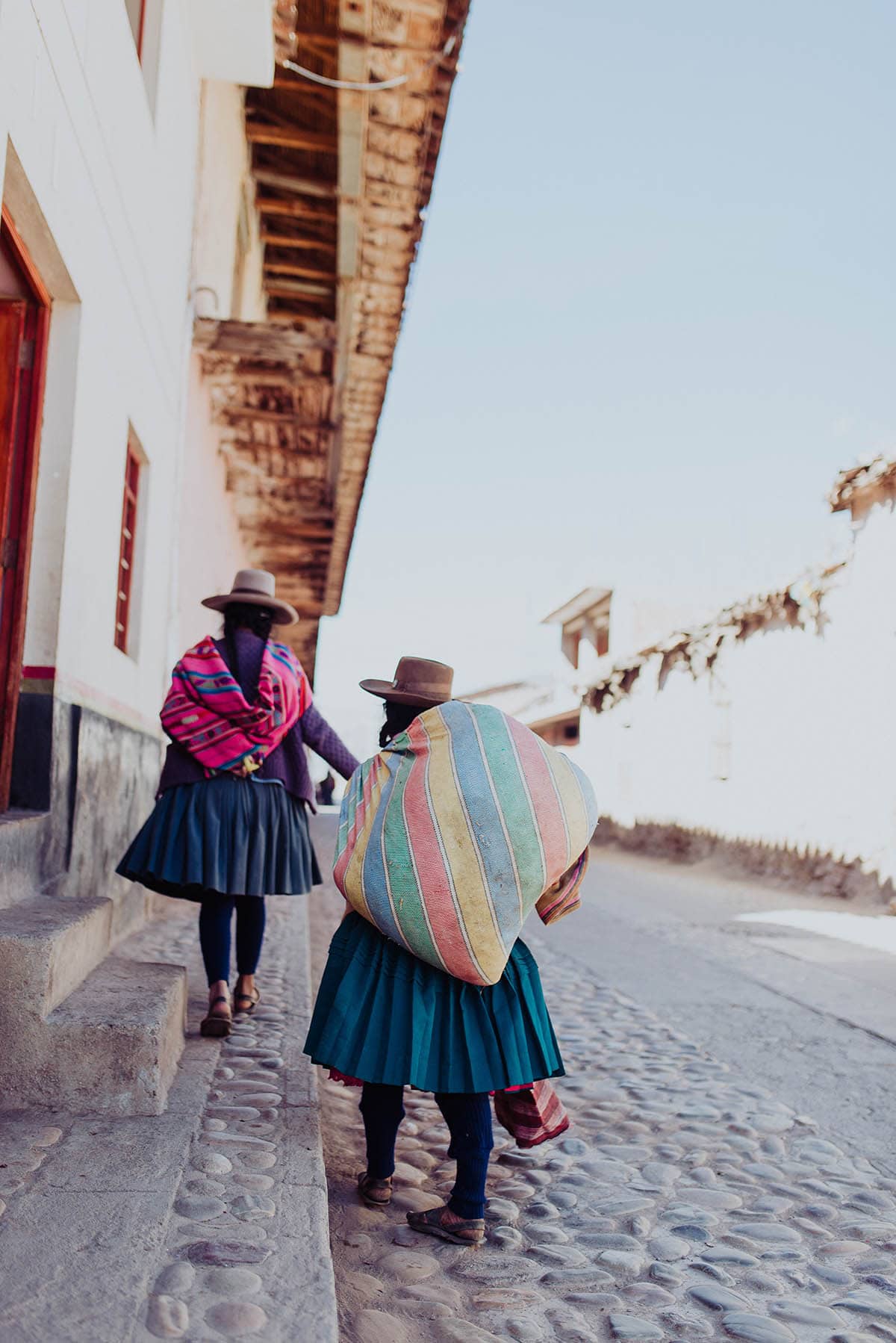
Andean women walk down a cobblestone street in Peru.
Before you travel, take time to learn about the history of a place and some basic phrases in the local language. This will create a more meaningful travel experience and opportunities for connection and conversation. Pause to soak in a landscape; reflect and ask questions; absorb the local flavor and feel. Patronize locally owned and operated establishments. Getting off the beaten path is not just about seeking novel experiences, it’s about making real connections to the place we visit and the people who live there.
While planning your trip:
During your trip:
As conscious travelers, we can harness our love of travel to improve the places we visit for the people who live there and for future visitors.
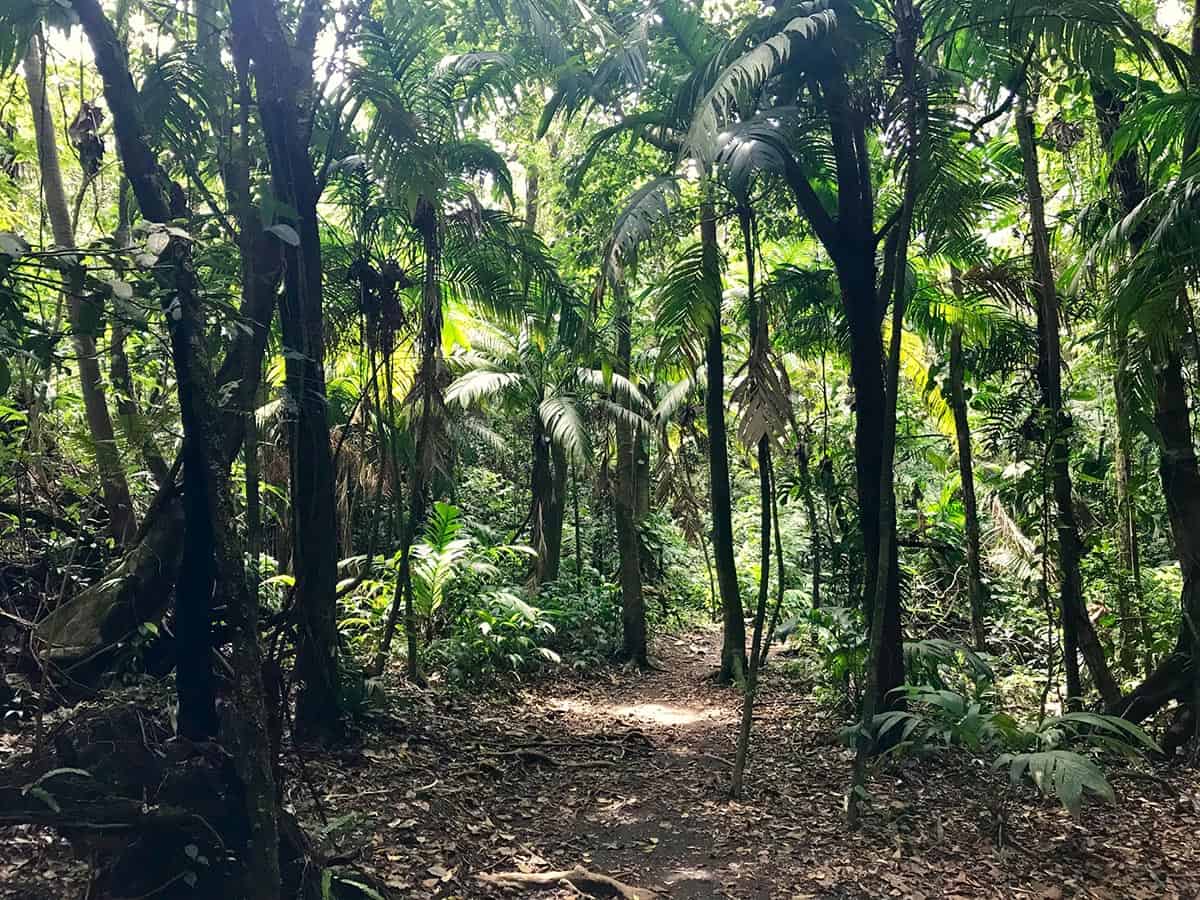
Trees in the Amazon Rainforest.
From the iconic Inca Trail to the stunning Cordillera Blanca mountain range near Huaraz, Peru is a wonderland of endless trekking opportunities. Yet, there’s a real risk of causing irreversible damage on the natural beauty with the increasing number of tourists visiting these areas every season. While most trekkers won’t hike independently in Peru, but with a guide, it’s still important to be aware of positive hiking and camping practices to keep the environment intact.
Andean waterways and lakes are fragile ecosystems and sources of drinking water for local people, so don’t be tempted to bathe or wash clothes en route. Most guided treks in Peru provide you with warm water at the start and end of each day to wash with; just make sure you dispose of used water carefully – at least 65 feet (20 m) from any natural water source. After all, part of the experience of an adventurous trek is to go a few days without a proper shower.
Stick to marked paths to avoid more erosion – tempting as shortcuts might look, trampling boots damage the fabric of the hillside.
The Cusco region is a UNESCO Natural World Heritage Site famous for its species of rare flora and fauna – so leave them where they look best – in their natural homes.
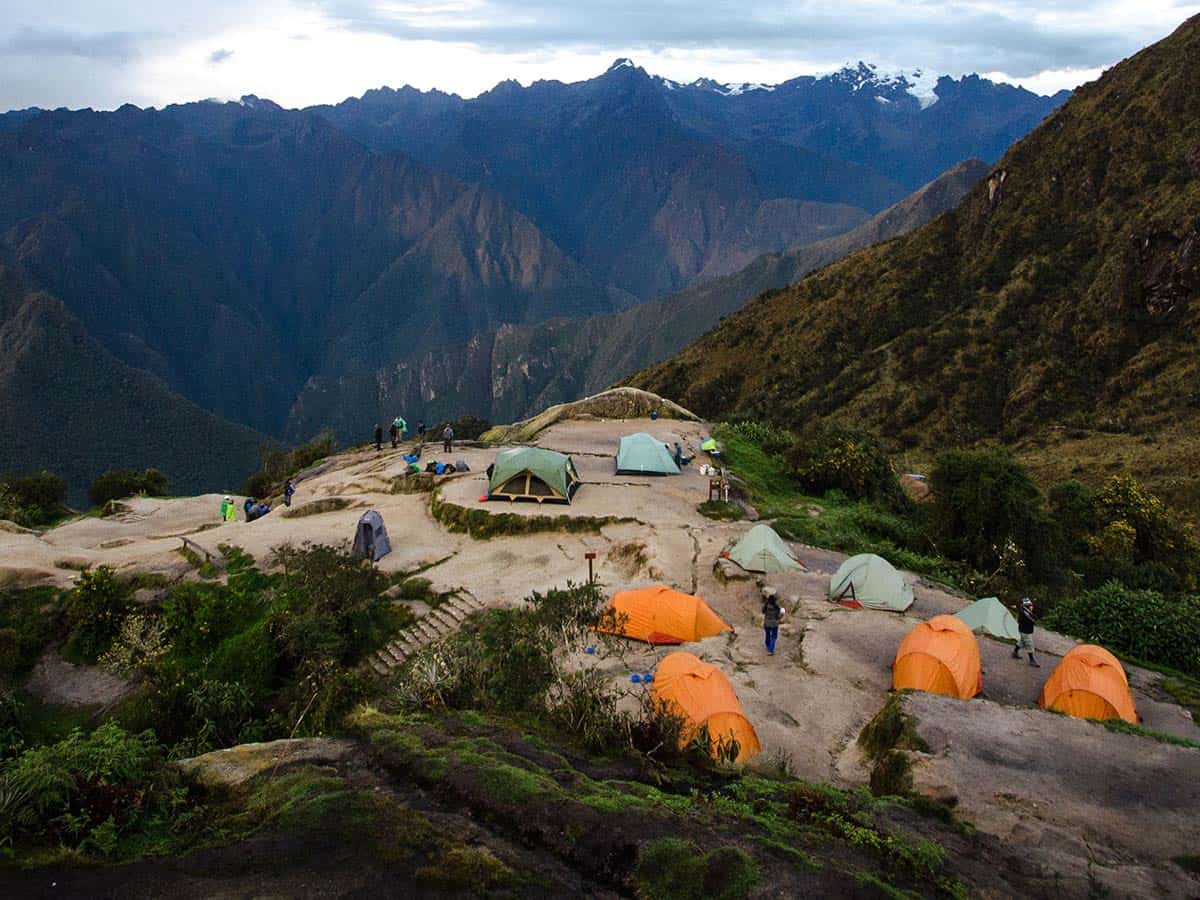
A campsite overlooking the Andean mountains. Photo by Clement Taquet.
Be considerate when camping by leaving no sign you were there. Don’t camp in ruins as ancient walls could get damaged. Campfires are risky so stick to camping stoves for cooking and extra layers for keeping warm.
Carry all waste off the mountain and keep an eye on other members of your group and ensure they do the same.
Take plenty of waste bags to carry out trash; or even better, minimize the amount of waste you’ll produce by taking your food and drink in reusable containers.
Always use purpose-built toilets along trails, but if needed, make sure you’re at least 150 feet (45 m) from both the path and any water source, dig a small hole and bury well.
It’s important to be a conscientious outdoor adventurer. Follow these guidelines about trekking responsibly and keep the Peruvian landscapes pristine not just for future generations of travelers but also for the plants, animals, and people that call the region home.
As travelers, we know that reducing our collective carbon footprint is sometimes the last thing we think about when preparing for a trip. But in reality, being green is the most important thing you can do during your adventures.
Being an informed and environmentally conscious traveler is just one facet of promoting sustainability within the tourism industry in order to preserve and protect the environment as well as the local cultures.
Plastic is harmful to the health of land and sea life, so making a wholehearted effort to use less of it on your journey will make a big difference, especially to the local people you meet along the way. After all, your travel destination is their home. On your next vacation, consider these eco-friendly, plastic-reducing tips to ensure that you leave the tiniest, almost non-existent carbon footprint possible.
Unfortunately, consuming bottled water in Latin America is unavoidable. Because of the poor water sanitation infrastructure in many countries, it is inadvisable to drink water from the tap. But there are ways to reduce how many plastic bottles you consume throughout your trip.
First, bring a reusable water bottle, or purchase one at a local market. This will allow you to refill it an infinite number of times. Buy water in bulk and leave it in your hotel room for use throughout your stay. Many grocery and convenience stores sell bottled water by the liter or more, and often times an attendant will help you carry it a short distance for a few soles.
This is very useful if you plan to do a lot of hiking during your trip. Water from the tap or fresh spring water can be made safe to drink through a variety of methods.
One of the easiest ways is by purchasing water purification tablets before your trip from a sporting goods store like REI or Big 5. Another option is a UV light stick that neutralizes harmful bacteria present in untreated water. Then there’s the old fashioned boiling technique.
One of the best ways to reduce your plastic consumption while traveling is to stash your stuff in reusable cotton or recycled plastic bags. Bring as many as you think you might need. You can also purchase a beautifully handcrafted bag along your journey to provide you with a tangible, lasting souvenir, as well as the warm fuzzy feeling of knowing that you contributed to the local economy and did Mother Nature a favor.
While travel size toiletries are convenient, they can come at the cost of the environment. Instead of buying lots of toiletries in small plastic bottles, consider making little switches in the products you decide to bring along. It can make a big difference for the environment. Try bringing bar soap in a reusable soap traveler container. This is not really a huge sacrifice because many body washes that are sold in plastic bottles also come in the bar form, such as Dove, Caress, or Lever. You can also bring a razor that uses refillable cartridges or that is electric, instead of using disposable ones. To go the extra mile, purchase biodegradable, chemical-free bath products.
Plastic eating utensils are one of the most harmful wastes for the environment and your health. Plastics cutlery and Styrofoam to-go containers are made from #6 PS (polystyrene) which is made from petroleum by-products. These products are made to be lightweight which means the wind can easily carry them into natural habitats like the ocean or other sensitive ecosystems. Pair that with the fact that they take millions of years to decompose and you’ve got a few environmental issues on (and in) your hands. You reduce your plastic use during your travels by bringing your own set of eating utensils or requesting metal ones at the hotel.
Machu Picchu is one of those places that makes the top 10 of almost every bucket list. It’s not just the ruins that call curious travelers from nearly every corner of the world, but also the robust culture, beautiful landscapes and endless sense of adventure.
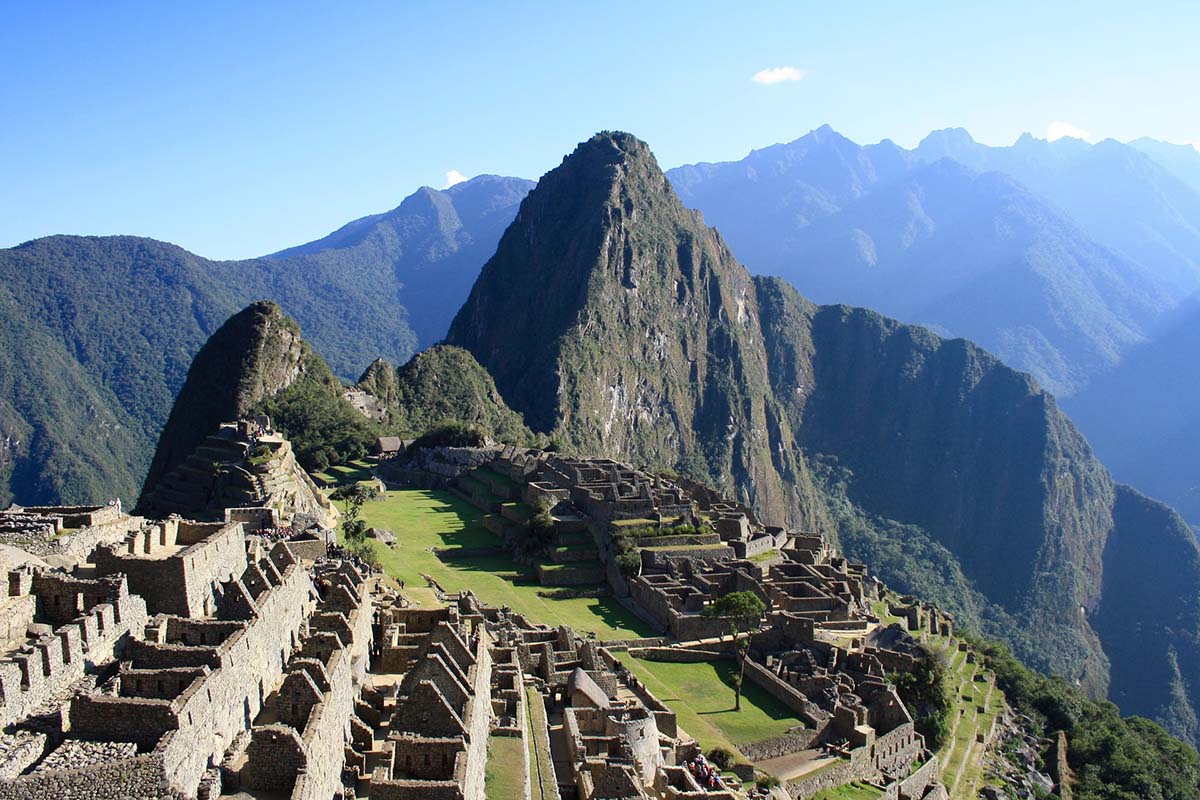
The ancient ruins of Machu Picchu.
But, with millions of travelers visiting every single year, Machu Picchu and the surrounding area are at risk, both environmentally and culturally speaking.
That’s why we at Peru for Less sat down with our resident Machu Picchu expert, Fabricio Ortiz, to get tips and tricks on what steps visitors can take to preserve Machu Picchu, along with the ecosystem, customs and lesser-known ruins that surround the Inca citadel.
Over the past decade, Machu Picchu and Cusco have become havens for traveler from all over the world, and in some cases there have been visitors who have been less than respectful of the sacred ruins. In March of 2014, a number of young tourists decided to strip naked and expose themselves during their visit to Machu Picchu as part of the “naked tourism” fad. While streaking in some parts of the world can make for a good story and interesting pictures, doing it in Peru can make for some serious trouble, especially now that the government is cracking down on those who expose their cracks. Their obscene act ended in detainment and eviction from Cusco.
The trail that winds through Machu Picchu not only protects the ruins, but also the people visiting. At more than five centuries old, some of the structure is worn, cracked and deteriorating. Meandering from the set path could not only further damage the walls and flooring, but also lead to a visitor hurting themselves. After all, the citadel is on the side of a mountain and it’s a long way to the bottom.
While it’s tempting to touch the massive rocks chiseled by the hands of the Incas, it’s a bad idea. Lotions, sunscreens and bug sprays all contain chemicals that can damaged the rock surface. Additionally, thousands visit Machu Picchu every single day; imagine the wear and tear that would take place if each of them dragged their fingers along the citadel’s surfaces.
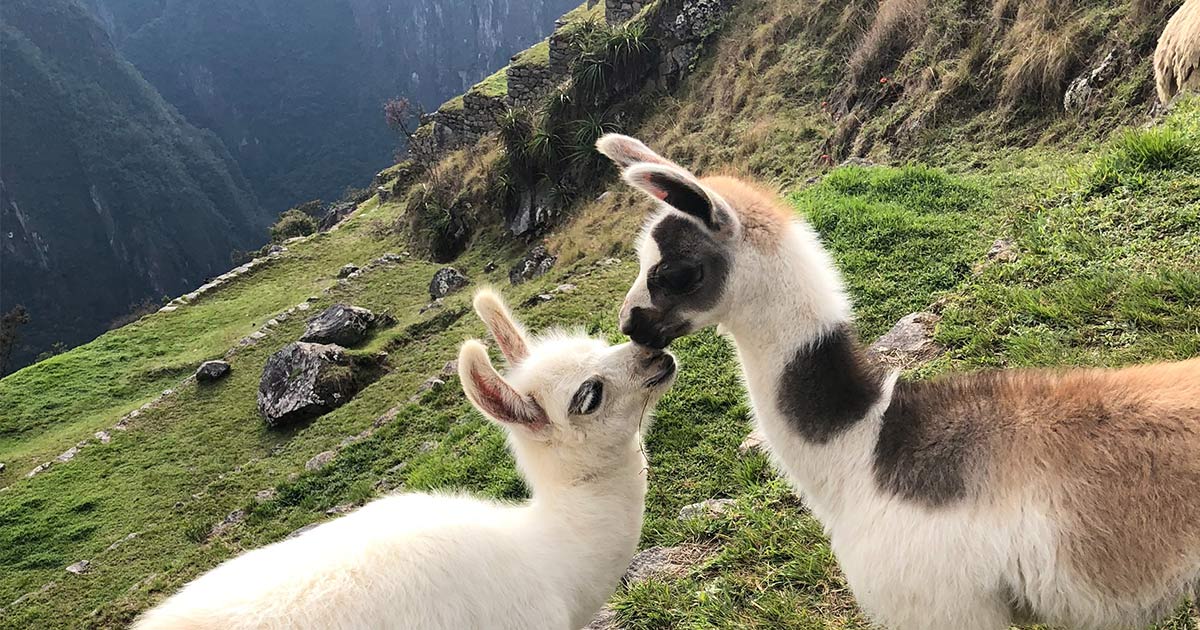
Photo by Yury Dhaliah on Unsplash. Cropped and compressed from the original.
Although they are cute, snuggly looking and incredibly used to humans, llamas are known to spit, charge and even bite if they feel threatened. The llamas, who the Incas openly worshipped, call Machu Picchu home — be sure to respect them on their turf. On top of that, they aren’t always the cleanest animals and carry disease, fleas and mites.
This not only goes for waste pollution, such as bags and bottles, but also noise pollution. It not only disturbs the plant and animal life, but also the experience for other travelers. Many of them have traveled great distances to experience Machu Picchu, and some even view the sacred site as a spiritual one.
Watching the sun appear over the horizon, followed by the fog and clouds dissipating into thin air and finally, witnessing the sun set into the majestic mountains makes for a very long day at Machu Picchu. Eating and going to the bathroom inside the ruins are strictly prohibited. Luckily, there are a couple of restaurant choices and clean restrooms just outside the gates. Head there to relieve hunger (or yourself). Keeping the ticket ensures re-entrance.
This goes for not only items like plastic bottles and wrappers, but also fruit and vegetable waste like apple cores, as well as cigarette butts and chewing gum. Don’t throw anything on the ground of Machu Picchu that you wouldn’t want on the floor of your own home.
All trash, including plastic drinking bottles, has to be shipped from Machu Picchu to Cusco City via train. Help reduce waste by carrying water in a bottle that doesn’t get tossed when emptied.
Peru is home to dozens of endangered or protected plant and animal species, including jaguars, pumas, caymans and monkeys. Never buy a product made of a threatened plant or animal species.
Make sure you are asking for permission before snapping a shot of the locals clad in intricately sewn outfits or of government workers like soldiers and police officers. Additionally, locals follow Catholicism, Pachamama (Mother Earth) or a hybrid of the two. Observe the sanctity of their religion. When the town are celebrating their patron saint or other religious festivals, make sure to be respectful during the street processions and moments of silence.
This goes for pieces of the ruins and the natural flora and fauna that call them home.
Traveling to Peru is an enjoyable experience that can be incredibly rewarding, but how do we make sure that our time spent in the country gives back to the local people that help make our trip so special?
Peru’s economy is developing and many indigenous communities still live challenging lives in areas that tourism touches. Their economic instability along with a heavy dependence on tourism leaves many Peruvians in vulnerable positions. However, there is plenty you can do to help their situation during your time in Peru.
Try buying Peruvian when in Peru. Make the most of your time in this foreign country and try the local cuisine rather than sticking to home favorites. Patronize independent, local establishments rather than ‘go safe’ in familiar chains. By doing this, you’ll be putting your money into local hands rather than distant global companies.
Same goes for when you’re shopping for souvenirs – much better to take home a genuine memento of the country, handcrafted in the place you visited, rather than a mass-produced item from China. Just double check that what you’re buying isn’t plundered from the jungle or made from an endangered species.
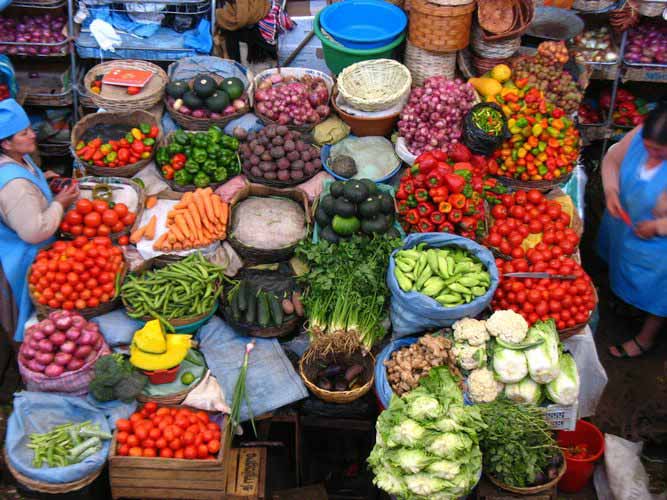
Fuel your trip with colorful, locally grown produce. Photo by RastaChango.
When you’re booking a trek or tour, ask the right questions to make sure the company treats its guides and porters fairly and looks out for their welfare. Check that they are paid fair wages; ask if they follow the legal weight limits for porters to carry, see that they are given the right equipment, clothing and shoes for a trek, and find out how they respect the cultures and environments the tour will take you into.
Trekking Tours:
Eco-lodges and hotels are cropping up more and more in Peru, so stay in one when you can! Eco-friendly hotels focus on providing sustainable accommodation for guests therefore creating the least impact on the local environment and consequently the people that live there. It might also mean that they utilize local resources, such as wood for furniture or foods from nearby permaculture farms.
Ecotourism is most developed in Peru in the tourist hotspots of the Amazon and Andes regions.
Homestays are also a great way to ensure your money is going directly to local people – and you’ll have a warm experience staying with a family while getting to know their life and culture.
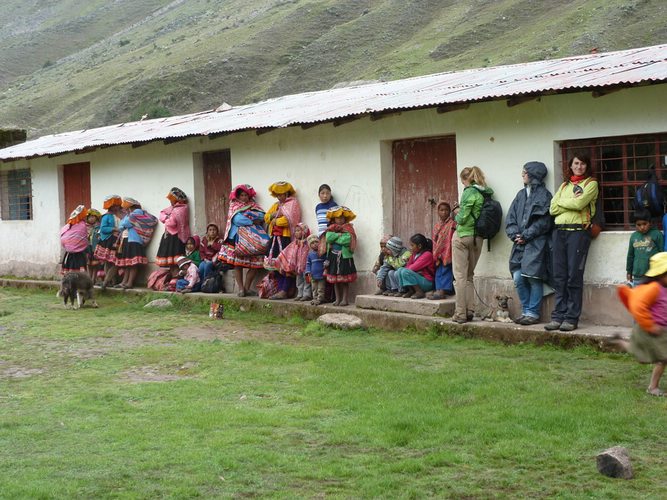
A local community in the Peruvian Andes.
By joining community-based tourism projects, you’ll increase the demand for this type of vacation in Peru, so where you can, get involved! Whether it’s tilling the land, feeding the animals or learning how to dye sheep’s wool, it will be an experience that you’ll be able to dine out on for years to come, and you’ll feel reassured that your vacation activity has really helped a local family.
The same goes for wildlife-watching tours and visits to national parks and nature reserves: you will be reinforcing to local powers-that-be that preserving the natural environment and indigenous flora and fauna is important for their economy. The more tourists that want to see nature at its best, the more it will be conserved, and the more money will come into the community that looks after it.
Ecotourism is a cornerstone for the tourism industry in Peru’s jungle destinations. If volunteering is not part of your trip, staying at an eco-friendly lodge is another superb way to exercise responsible travel.
Amazon ecolodges emphasize the importance of reducing environmental impacts and respecting local knowledge. From materials used to construct it to everyday business operations, each eco-friendly lodge is dedicated to putting sustainability into practice while at the same time giving back to the indigenous communities of the Amazon region.
As an ecolodge guest the result is an amplified experience which fosters your appreciation and respect for the natural beauty and traditions of the jungle. You also become an agent to change and advocate for raises awareness of the severity of the problems facing the Amazon region and the people who live there.
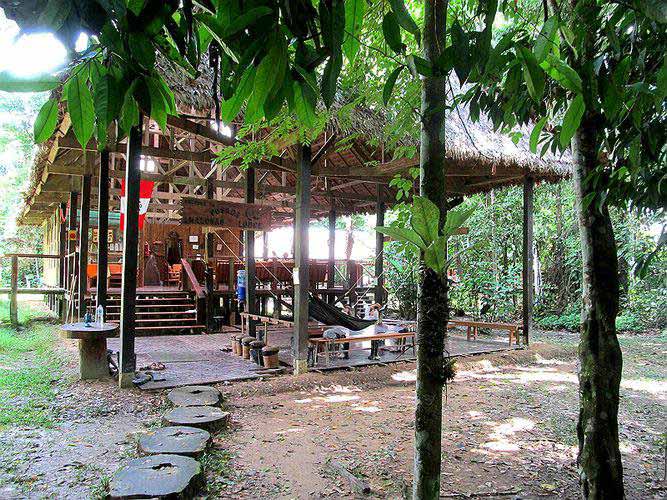
Posada Amazonas Lodge.
Posada Amazonas is owned by the local Community of Infierno and managed in partnership with Rainforest Expeditions. From the cooks to your jungle guide, the staff you interact with at the lodge will likely be from the area. In this way, the lodge is a source of livelihood for the community and proceeds are also recycled into development projects that further the sustainable practices of the lodge.
Nestled amid jungle vegetation and less than an hour boat ride from Puerto Maldonado, Posada Amazonas is ideal for an introduction to the jungle. The lodge’s open-air design spreads over a single level property and extends into all of its three-wall guestrooms that open into a windowless veranda for close contact with the jungle environment. Nature activities include exploring an ox bow lake that is home to a family of giant river otters, visits to a parrot and macaw clay lick, and seeing over the jungle from a 40 meter tall canopy tower.
Posada Amazonas Lodge is located 45 minutes by bus plus another 45 minutes by boat from Puerto Maldonado. Traverse through 9,500 hectares of private, protected rainforest—a concession given by the government.
For more information, visit Rainforest Expeditions.
Muyana is a small-scale lodge located upstream from Iquitos not far from the Pacaya-Samiria National Reserve. Mimicking local design, the thatched-roof buildings at the lodge are constructed on stilts to prevent flooding when the Amazon River runs high. Guest bungalows are basic, but comfortable, and include a terrace overlooking the forest or river. Guided activities include canoe trips to spot wildlife in the surrounding lakes, birdwatching, night hikes, and visits to a local community.
Many employees and guides at Mayana are from the nearby small village of San Juan de Yanayaca, so local families benefit from tourism too. The lodge has a recycling program and provides guests with organic bath products that are environmentally friendly, prepared meals using locally grown produce. The site is three hours by boat from Iquitos.
For more information, visit Muyuna.
Peru is the 10th most forested area in the world and beholds 13% of the Amazon rainforest. In fact, more than half of the country is covered in forests—that’s 260,000 square miles of trees. As a result, it is also one of the top 10 most diverse places on the planet, and each and every plant, animal, and person depends on these mighty trees for everything from the food they eat to the air they breathe.
Unfortunately, more than 1000 miles of Peruvian rainforest is cut down every year. It is one of the most rapidly deforested and degraded places on earth, and an alarming 80% of this deforestation is done illegally. Without the Amazon, billions of pounds of CO2 would contaminate the atmosphere and 10% of the world’s biodiversity would be lost.
Luckily, there are many people working to end deforestation, and many things you can do to support this process. For example, there are organizations like Progreso, Ecosia, and One Tree Planted that aim to reforest the mountains and jungles of Peru. By supporting these organizations, contacting your elected officials, reducing paper and wood consumption, reducing beef consumption, and spreading the word, you truly can help make a difference.
Macaws stand out from other jungle wildlife because of their beauty and curious habits. They also star in this amazing documentary project brought to us by the research team and creative minds from the Tambopata Research Center.
“The Macaw Project” shares how illegal mining and logging endanger macaw populations living in the Tambopata Reserve in southeast Peru. The hope is that viewers will gain a better understanding of how these threats are causing widespread devastation throughout the Amazon and the dire need to protect its fragile ecosystems.
For travelers, the message of the documentary is not to stay at home, but rather visit with a responsible conscience and be an agent for change.
Conservation efforts in the Amazon go hand-in-hand with the development of a sustainable ecotourism industry. For our Peru for Less team, the decision to sponsor and support “The Macaw Project” documentary was a no-brainer.
Peru for Less is doing its part to make sure our impact on the places we travel to is a positive one. We work with hotels and tour operators in Argentina, Bolivia, Brazil, Chile, Costa Rica, Ecuador and Peru who make conservation, sustainability and community development a priority. Because we work directly with locally owned companies who employ the people who live there, the money spent by our clients stays within the community. Our providers are involved in reforestation projects, conservation initiatives and low-ecological footprint programs like incorporating recycling, biodegradable cleaning and bath products and low to no energy devices to power their day-to-day operations.
At Peru for Less, our top priority is to provide travelers with an experience that connects them to a culture, a country and an environment different from their own while also empowering local communities. After all, our responsibility is not just to curious travelers, but also the people and places they are going to see.
Contact us to start planning your own sustainable ecotourism adventure in Peru.



Email: [email protected]
Sign up to receive our newsletter for great articles, stunning photos, and special deals.